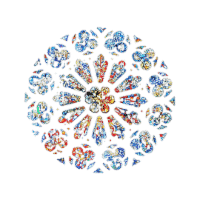Grace Cathedral

Article | December 2, 2021
Light and Peace — Anticipating God’s Fullness
Blog|The Rev. Canon Anna E. Rossi
Moving forward, all Light and Peace articles can be found in the blog section of our website. New Light and Peace articles will be shared in the Congregation Update.

Any trip into Macy’s or Safeway at this time of year will obviate the experience of waiting. The lights, the sweets, the merry — it’s all here now! But the voyage inside — into the human heart or the womb of the cathedral — is always proleptic. By “proleptic,” we mean that although Jesus was born in Bethlehem of yore, Christ is coming again, into our lives and world, and Christ will come as the fullness of time and creation. That is the heart of the church’s season of Advent.
The church celebrates Advent (cf. Latin adventus meaning “arrival” or “approach”) beginning four Sundays before Christmas. Rich with themes of hopeful expectation, anticipation and waiting, Advent enjoins us to prepare a way for Christ’s presence, love and justice in our lives. Like Mary, Mother of God, we, too, are pregnant, waiting with eager longing to bear that life that will never die. Preparation requires discipline and self-examination, and so we hear John the Baptist calling us to repentance (cf. Hebrew תשובה or teshuva meaning literally “to return”).
Advent’s themes of preparation and repentance set it apart from Lent. Lent is a fully penitential season and a time of preparation for Baptism. In Lent, we bow the knees of our hearts, set aside our joyful alleluias, and undertake disciplines of prayer, fasting and almsgiving. But in Advent, even in minor keys and ancient modes, our refrain is “rejoice,” or “alleluia,” for the Lord is at hand.
Much of Western Christianity has typically used purple as the liturgical color in both Lent and Advent. The Anglican heritage is to use Sarum blue as Advent’s liturgical color, a dark hue which is also found in depictions of Mary, Mother of God, in Western European art.
The lectionary offers a specific focus for each of the four weeks of Advent:
• The first Sunday is “apocalyptic” (cf. Greek apokalupsis, from apokaluptein “uncover” or “reveal”), the unveiling of God’s presence when the world seems to be at the brink of collapse. Apocalypse is not predictive — there are always wars and rumors of wars. Rather, it is descriptive of how God reveals the Divine Presence in darkest night.
• The second Sunday introduces John the Baptist, a fiery preacher in the wilderness with a message of repentance.
• The third Sunday deepens the urgency of John’s message and his role as the forerunner of Jesus. This Sunday is also known as Gaudete (Latin “rejoice”) Sunday, taken from Saint Paul’s instruction to the church in Philippi to “rejoice always” (Philippians 4:4).
• Finally, the fourth Sunday of Advent announces the coming of the Christ Child with Gabriel’s Annunciation to Mary.
Like pregnancy, our anticipation takes time, most especially prayerful time. In that spirit, join the cathedral community in our patterns of weekday prayer, including Weekday Morning Prayer (9 a.m. on Zoom), Tuesday Evening Prayer (5:30 pm on Zoom), Wednesday Noon Eucharist (in-person in the Chapel of the Nativity). And don’t miss the Advent Procession — an annual tradition with stational Lessons and Carols, sung by the Cathedral Choir of Men and Boys.
Purify our conscience, Almighty God, by your daily visitation, that your Son Jesus Christ, at his coming, may find in us a mansion prepared for himself; who lives and reigns with you, in the unity of the Holy Spirit, one God, now and for ever. Amen.
— Collect for the Fourth Sunday of Advent






